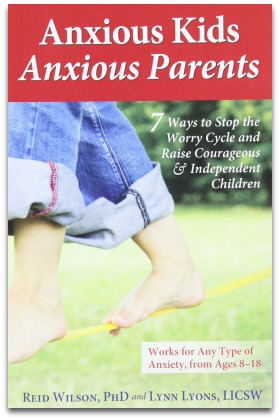 That knot in the pit of your stomach?
That knot in the pit of your stomach?
That hand squeezing your chest?
That voice telling you this is all going to go horribly wrong?
That is anxiety, my friends.
It’s hard enough to deal with that feeling of dread and worry in myself, but it is heart breaking when my kids look up at me with big blue eyes full of worry and tears and tell me, “I just can’t do it, Mommy.”
Both of my boys have struggled with anxiety. My oldest was bullied in 2nd grade. The constant verbal assaults on him resulted in stomachaches, headaches, begging to be homeschooled, not sleeping, and going to the bathroom every 30 minutes. All are on the menu of classic symptoms of acute anxiety.
My youngest just seems to be a worrier. About once a week he comes out with some new thing to worry about. Currently his greatest worry is that he won’t make enough money from his art to support himself. He is 6.
My kids aren’t alone in being anxious worriers. Every child experiences some anxiety. Before tests. At concert performances. The first day at a new school.
Anxiety and nervousness are normal as long as it doesn’t get in the way of their everyday lives. Once that happens it’s time to seek some professional support.
So, if your child is a worrier who does not need professional intervention, how can you help them process through these moments of chest-tightening, stomach-churning worry and learn to lead a calmer, happier life?
#1 Get Them Talking
 Anxiety exists in a vacuum. It thrives in a world where there are no facts that can disprove the dark stories that play through the mind.
Anxiety exists in a vacuum. It thrives in a world where there are no facts that can disprove the dark stories that play through the mind.
Get them talking about what they fear will happen. Be there to listen to the worst-case scenario they are 100% positive will happen if they walk through those doors and into their classroom.
Using active listening will help tease out exactly what they think will happen. Once they say it out loud, the anxiety that is squeezing the breath out of them starts to loosen a bit.
By talking to you they aren’t alone with their fear anymore.
#2 Write a New Story
Every time I hear “I am so nervous that I’m going to mess up,” I am always tempted to say, “Nothing like that is going to happen. You’ll do wonderfully!”
Don’t. They won’t believe you anyway.
My boys are extremely creative storytellers with huge imaginations. The story they have created in their head is too strong and too real for anything I say to push all of that anxiousness away from them.
And worse, if I tell them everything will be just fine and then things aren’t 100% perfect, I am liar. And I have just confirmed their darkest fears are true.
What I can do is help them write a new story.
I can’t eliminate their fears entirely, but I can give them a new script to follow. One that can put this worst-case scenario into perspective.
Ask them what exactly would have to happen for their worst fears to come true. Get all the dialogue and details. The more outlandish the better. Get them laughing at the entirely unlikely course of events that would have to happen to ensure total failure.
Then ask the most important question: “Has anything like that has ever happened to you before?”
The answer is probably no.
Now talk about what a realistic scenario for them might be. Be just as detailed as with the worst-case scenario. Walk through all the very likely things that might happen and build with them a realistic vision of what success looks like at the end.
And because this is a realistic scenario, I include how nervous they are in the story. Without it, the minute they feel nervous without having planned for it, the confidence they have in the new script starts to fall apart. The worst-case scenario starts to creep back in. With the nervousness interleaved right into story, the new script still holds, no matter how nervous they start to feel.
#3 Don’t let them avoid the cause
When they come to me with their hearts full of worry, there is nothing I want more than to protect them.
“Don’t make me go to school!”
“I don’t want to go to the party.”
“I’m going to get homesick at the sleepover.”
I would love to let them skip school, or stay home from the sleepover, or miss any other activities that make them nervous.
 However, I might be doing more harm than good. Reid Wilson and Lynn Lyons, authors of Anxious Kids, Anxious Parents say:
However, I might be doing more harm than good. Reid Wilson and Lynn Lyons, authors of Anxious Kids, Anxious Parents say:
“The first [mistake] is trying to meet anxiety’s demand for certainty. Parents hope to alleviate worry by continually reassuring, planning for, or accommodating their anxious child. Second, when this fails—because absolute certainty is impossible—parents then allow the child to avoid important activities, like school, social gatherings, or outings. Although parents believe they are helping their children by keeping them calm and comfortable, these actually make the anxiety stronger. The more anxious children avoid, and the more they seek security and comfort, the more they become trapped by their anxiety. Their world becomes smaller and smaller.”
As hard as it is, they need to confront what makes them anxious. They need to live through it and see that the fear lies in their head.
The new story we build together will help them become happy warriors, as will knowing that you will be there afterwards to actively listen to them.
#4 Build Comfort Routines
There is something beautiful in a routine. When I was a kid, I liked to go to church. I liked the ritual and routine of the singing, kneeling, praying, and meditation. It comforted me and all my worries and anxieties were left outside the big wooden doors.
Nowadays I practice yoga and meditation. I have a usual time and a usual place and none of my worries are allowed to come with me onto my mat.
I am building these routines with my children, too.
The easiest routine I have found to be consistent with is yoga. Since I do yoga myself, the boys also want to do yoga with me. I began with a simple routine called Sun Salutation.
It only takes about 5 minutes, but it gets them to stretch their muscles and practice deep breathing. The yoga mat has become an anxiety-free space for their minds. It is a refuge where they can come when they are feeling nervous or overwhelmed.
Or we try some quiet meditations. The Internet is full of wonderful (and free) meditations just for kids. I have a few downloaded onto my iPad that the boys can listen to. Evan’s favorite is the Guiding Star Meditation.
Your kids might not be into yoga or meditation. They might be into running, or soccer, or basketball… that’s fine. Just find a routine that ties into what they are interested and make it work for them.
And it doesn’t even have to be that. A comfort routine can even be something as simple as The Bedtime Routine.
Bedtime in our house starts promptly at 7:30pm with jammies and brushing teeth, then stories and a book on CD until they go to sleep. It’s the same every night.
And since bedtime happens each day, by practicing your children’s comfort routines at bedtime, you help them cleanse their daily worries each day.
#5 Work on Developing a Growth Mindset
 In my research, I have realized that my little worriers have a lot in common with children that have a fixed mindset that Dr. Carol Dweck explores in her uber-popular book Mindset: The New Psychology of Success.
In my research, I have realized that my little worriers have a lot in common with children that have a fixed mindset that Dr. Carol Dweck explores in her uber-popular book Mindset: The New Psychology of Success.
A lot of their anxiety stems from a fear of failure. A child with a fixed mindset also has an intense fear of failure.
Children with a fixed mindset not only dread failure, but they also avoid challenges, believe their abilities finite, and feel powerless and blocked in the face of anxiety. Children with a growth mindset, however, enjoy challenges and don’t spend a lot of time fretting over mistakes or failures.
Helping children develop a growth mindset can also give them tools to process through their anxious moments. It provides a positive foundation to build other anxiety-relieving technique upon.
#6 Model Behavior
Watching us parents is the #1-way children learn behaviors. Therefore, it is important that we mindfully model the behaviors we want from our children.
I have a lot of opportunities to model how I handle anxiety. I am an anxious person. Am I going to be late? Am I going to make this deadline? Will the clothes get dry in time?
My biggest phobia is the dentist. I do not like going to the dentist. Even taking my kids to the dentist takes days of mental preparation.
I would love to push the boys’ dental appointments off onto my husband, but I can’t. So instead, I use all of the same techniques that I have taught my boys to use. I talk about what I’m afraid of. I re-write the scenario of what is going to happen into a more realistic and positive script. I make sure not to skip my daily yoga sessions. And then I charge right in and hope for the best.
And I talk through all of this so they can hear me. I let them see all the decisions I am making in getting beyond my anxiousness. I show them what getting beyond anxiety looks like from the outside.
It’s not perfect. It’s definitely messy. But it can be done. And I am proving that to them.
The 2-Minute Action Plan for Fine Parents
For today’s quick contemplation let us consider the following:
- How often does your child get a case of the nerves? What makes your child anxious?
- How do they react to being anxious? Do they carry on? Or do they try to avoid what is making them nervous?
- How to you handle your own nerves? What kinds of things make you the most anxious?
The Ongoing Action Plan for Fine Parents
Helping a child to get beyond their anxieties is a long process, so this long-term action plan is really important this time.
Develop an active listening habit. The more your child feels heard by you the more comfortable they will feel sharing their deepest and darkest feelings with you. Not only will this help your child get beyond the wall of anxiety, but it will also create a stronger bond between you.
Sit down with your child and start to write a new script for their worst-case scenarios. This works especially well for specific trigger moments (like that first day of school or a choir concert) when they are most likely to feel blocked by their worries and nerves.
Begin a comfort routine in your home. Talk with your son or daughter and figure out a routine that will help calm their minds and give them space to process their anxiety. Some schools are doing yoga and meditation in their gym and health classes, so your child might already have some relaxation tools they can use to build their own comfort routine.
Journal the journey. I am a big believer in getting my thoughts down on the page. I write about where my boys are on their journey, too. When it comes to their anxieties, I write about what they are nervous about, what I did to try to help them, and whether or not it worked. When I re-read them, I can see trigger patterns and also calming patterns.


We really need to make sure that our kid grows up as a happy person because dealing with lots of problems and stress as an adult might lead to depression but, if our child grew up as a happy person, he/she will know how to handle things positively.
I liked all of your suggestions. I can relate to your comments about the positive aspects of a routine. I had trouble getting my husband and his mother to adapt to a routine; in fact I found that my involvement in school activities limited my ability to follow a routine.
Because my husband and I are members of the Baha’i Faith, our children did not get introduced to the type of worship service that is linked to a routine. When I was teaching a Baha’i summer school I had one student that told me that he liked to memorize the Hidden Words.
Those are Baha’i passages that get a person thinking. In other words, a parent could encourage a child to memorize any of the passages in the literature or in one or more holy books that get people thinking. That would accomplish an additional objective as well. It would help to open the child’s mind.
Sue Chehrenegar\\
Hi Sue! I am glad you liked my suggestions. There are many other routines that you can develop. Like a “go to school” routine where you hand them their backpack, give them a kiss, and a “I love you. Ask good questions.” Or an after school routine where you serve a snack and ask them how their day went before homework. I would love to learn more about the Hidden Words in the Baha’i faith. Can you comment back with a link?